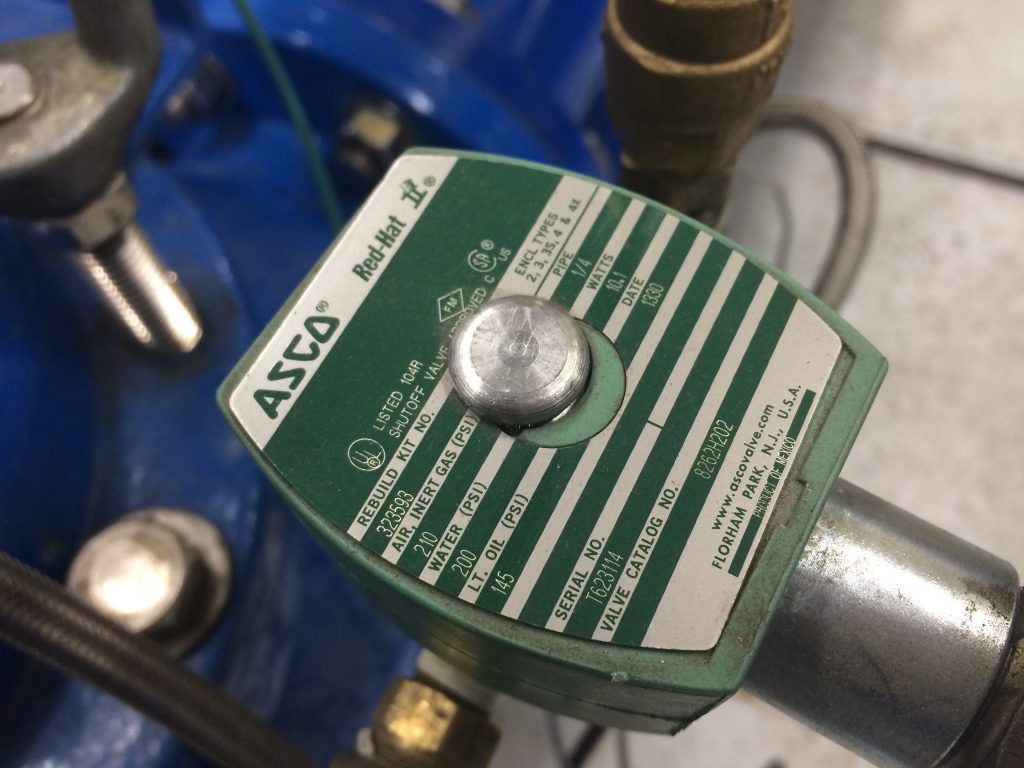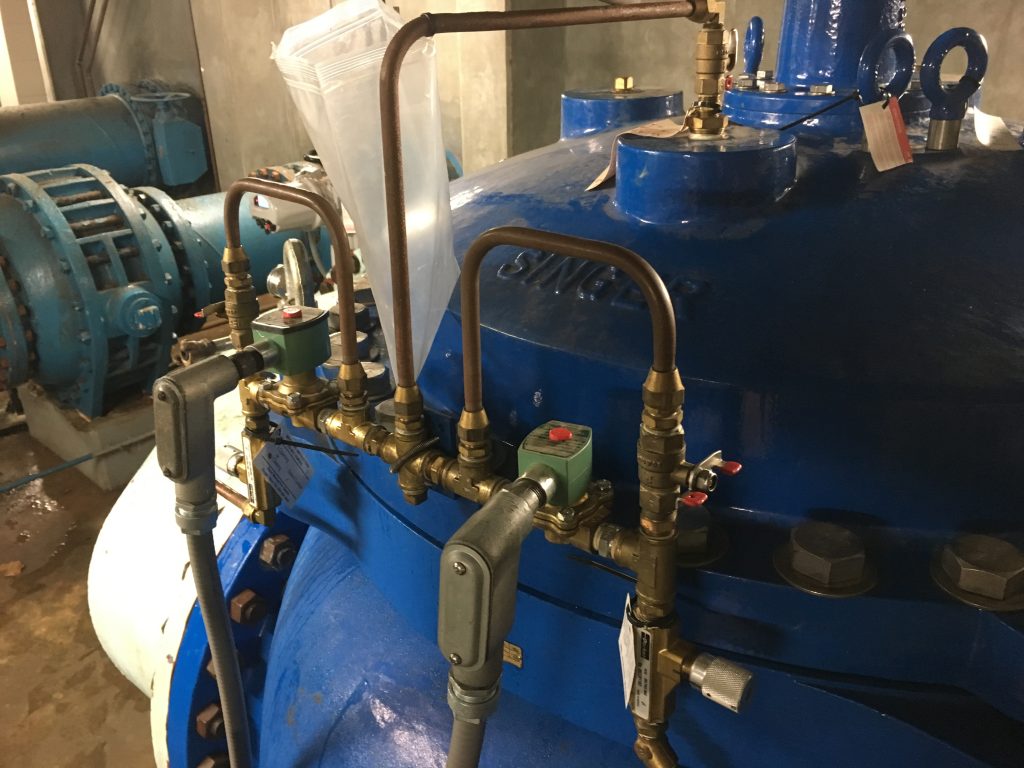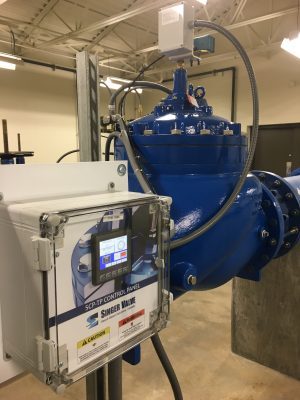Mechanically operated control valves have historically dominated the hydraulic control valve market. However, as technology advances, so too does the want and need for monitoring and control of water distribution networks. This has led to a huge interest for electrically operated control valves. By adding solenoids and controls, most mechanical valves can be easily upgraded to achieve electronic control of varying degrees. An electronic control valve can still complete any task that a mechanical control valve can, but has added versatility and ease for making frequent adjustments to improve operational efficiencies.
Before diving into the exciting world of electronic controls, it is important that the mechanical hydraulic set up is done correctly. This article will focus on how to successfully commission a modulating solenoid electronic control valve.
- Forget the Electrical
- Start by turning off all power to the control valve. This will allow the commissioning of the valve mechanically first, isolating the valve from any possible electrical interference.
 2. Know your Valve
2. Know your Valve - One of the most important steps is to determine the orientation of the solenoids on the modulating solenoid electronic control valve. Look at the manufacturer details to determine if the opening/closing solenoids are normally open or normally closed in orientation.
- In the event of power loss, different orientations can be used to allow the control valve to fail last, fail open or fail closed.
- These orientations will also affect how the mechanical override bypass ball valves are operated to mechanically move the valve.
3. Gain Control of the Valve
- The assumption in the ideal start-up procedure is to gain control of the valve and begin with the valve fully closed. There may be cases where the ideal start-up is to have the valve open to a certain degree, but a similar step procedure should be followed.
- As the valve is likely a new installation at this time, the line is assumed to be isolated by a butterfly or gate valve that is closed. Manipulate the mechanical override bypass ball valves on the control valve so that when water is available, it will hydraulically force the valve closed. It may be helpful at this time to dial the closing speed control to full open to maximize closing speed.
- Slowly open the isolation butterfly/gate valve and ensure the control valve either remains closed or begins to close and bleed air from bleed screw. If the control valve is not closing, stop opening the isolation butterfly/gate valve and allow time for more air from the bonnet to be bled and replaced with water and gain momentum to close. If the butterfly/gate valve is opened too quickly there is a risk the valve will float fully open and now the water line is being subjected to fully open line pressure and flow, which may be unsafe.
- Once the control valve is fully closed and air is fully bled, close the bleed screw and fully open the isolation butterfly/gate valve. The control valve is now fully in control of the water line.
4. Getting the Ball Rolling
- Before starting to manipulate the control valve, ensure the parameters of the system are known and that the valve is manipulated only within the parameters allowed to ensure safety.
- Dial opening/closing speed controls of the control valve all the way closed, and then dial speed controls one full rotation open.
- Manipulate the mechanical override bypass ball valves on the control valve to open the valve and start flowing water.
- Manipulate the mechanical override bypass ball valves on the control valve to lock valve and allow valve to remain at constant flow of water.
- Manipulate the mechanical override bypass ball valves on the control valve to close valve and stop flowing water. If the valve performs as expected, then the valve is considered to be mechanically operational.

5. Set the Limit and Stay within it
- Setting the speed control is a very important setup procedure as it sets the maximum opening and closing speed of the control valve. The control system may be able to further slow the valve down but, if there is any failure in the control system, the speed controls become the safety net.
- Adjusting the speed controls should ideally be done with reference to the process variable that the valve is trying to control. For example, if the valve is controlling the downstream pressure in a pressure reducing application, then when setting the speed control, the downstream pressure should be viewed. The objective is to achieve the best pressure rise or drop per second/minute that the system ideally can handle. For example, if the pressure rise or fall is too fast the control valve can introduce large surges in the system and be a big safety risk.
- Repeat step #4, but this time pay special attention to the opening and closing speed of the valve. Adjust the opening and closing speed controls until a desired equal speed of opening and closing of that valve is reached.
6. Be the Control System
- The easiest way to check the newly set speed controls of the valve is to manually manipulate the valve acting as the control system. Try adjusting the valve by manipulating the mechanical override bypass ball valves to user specified setpoints. For example, if the valve is controlling the downstream pressure in a pressure reducing application then try to control the valve to the specific pressure.
- If the setpoints cannot be achieved manually then there is a likely chance that the control system will have issues controlling to the setpoint. Repeat step #5 to adjust speed controls until a more desired speed of control is achieved.

7. Release the Valve to the Wild
- Once this step has been reached, the successful mechanical commissioning of the modulating solenoid control valve has been completed. Any issues during commissioning after this point can be isolated to the electrical portion or the controls.
- Ensure the mechanical override bypass ball valves no longer bypass the electrical solenoids enabling them to take control of the valve. At this point it’s time to sit back and allow the electrical control system take charge and work its magic.
As the waterworks industry grows and systems become more complex, the need to have multiple set-points and the ability to remotely change it is becoming necessary. Knowing how to commission your modulating solenoid electronic control valves correctly will help ensure your system runs smoothly.




